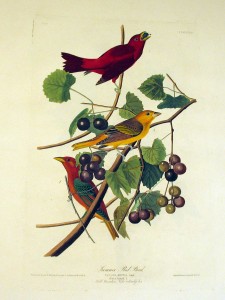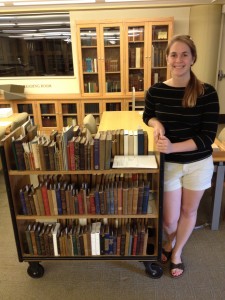I am pleased to announce that we have five (5) Creative Fellows this year in the Watkinson Library:
Michael Benson ’13 (Psychology) plans to explore the roots of hip-hop and rap in our collection of recorded jazz and blues music, and produce a CD of songs in a mash-up mix.
 Anastasia Edwards ’13 (Political Science and French) plans to design and produce a garment based on fashion and costume books in the Watkinson.
Anastasia Edwards ’13 (Political Science and French) plans to design and produce a garment based on fashion and costume books in the Watkinson.
 Julia Falkowski ’13 (English and American Studies) plans to create and cook from a “Watkinson Cookbook” of recipes culled from cookbooks, household guides, and other sources.
Julia Falkowski ’13 (English and American Studies) plans to create and cook from a “Watkinson Cookbook” of recipes culled from cookbooks, household guides, and other sources.
 Georgia Summers (’15, Undeclared) plans to write a mystery novel with fantastical elements set in the Watkinson, featuring its sources and collections in ways germane to the plot.
Georgia Summers (’15, Undeclared) plans to write a mystery novel with fantastical elements set in the Watkinson, featuring its sources and collections in ways germane to the plot.
Laika Abdulali ’13 (Political Science) plans to write a series of four short stories based on select pre-1900 travel literature. The final event date has not yet been set, but it will likely be held during the last week of April.
As we welcome the new cohort, I thought our readers would enjoy a few excerpts from the process journals of last year’s Fellows, to give a taste of their experience:
 Leslie Ahlstrand ’12, writing poems inspired by fine press books of poetry, week 3: My overwhelming feeling with the Watkinson is that I’m somehow missing something. Every time I go down to the stacks to find one book, inevitably many more books whose bindings glint & make me wish that I had somehow found/incorporated them, too . . . After looking through the private press books, I’ve gotten a much better idea of how to produce the group of poems I will write, if not what I plan to write about (that seems an ongoing clarifying process as I read more and more) . . .
Leslie Ahlstrand ’12, writing poems inspired by fine press books of poetry, week 3: My overwhelming feeling with the Watkinson is that I’m somehow missing something. Every time I go down to the stacks to find one book, inevitably many more books whose bindings glint & make me wish that I had somehow found/incorporated them, too . . . After looking through the private press books, I’ve gotten a much better idea of how to produce the group of poems I will write, if not what I plan to write about (that seems an ongoing clarifying process as I read more and more) . . .
 John Bower, ’12, re-telling Old Norse myths, week 2: I spent several hours just sitting and searching through the shelves this week. It was incredible. Many old of these books display astounding workmanship in production and also in the design. Some have hand-drawn title pages. If only today’s books displayed such craft. I looked through a few different areas in my search. Not only the children’s books and the area on Norse materials, but I also looked into an area containing mythology that I noticed while I was on the tour . . . There were some fascinating looking books on Egyptian mythology and belief. If I expand my project I will have to check these out (I may anyway).
John Bower, ’12, re-telling Old Norse myths, week 2: I spent several hours just sitting and searching through the shelves this week. It was incredible. Many old of these books display astounding workmanship in production and also in the design. Some have hand-drawn title pages. If only today’s books displayed such craft. I looked through a few different areas in my search. Not only the children’s books and the area on Norse materials, but I also looked into an area containing mythology that I noticed while I was on the tour . . . There were some fascinating looking books on Egyptian mythology and belief. If I expand my project I will have to check these out (I may anyway).
 Francis Russo ’13, composing music based on a French manuscript (1833) of songs, week 3: This week I looked at an amazing French book from the early 1800’s with hand-written music. Even though I don’t speak French, the melodies could still be useful, as they are simple and are short, song-like phrases. They are also unharmonized, so I would be able to shape the music by adding harmony and English text. Interestingly, whoever wrote the music must not have been too well-trained in music notation, because note lengths often exceed the space allowed in the bar or there weren’t enough notes in a bar to properly fill it. Nevertheless, the hand-written music was amazing to look at and was accompanied by hand-drawn images.
Francis Russo ’13, composing music based on a French manuscript (1833) of songs, week 3: This week I looked at an amazing French book from the early 1800’s with hand-written music. Even though I don’t speak French, the melodies could still be useful, as they are simple and are short, song-like phrases. They are also unharmonized, so I would be able to shape the music by adding harmony and English text. Interestingly, whoever wrote the music must not have been too well-trained in music notation, because note lengths often exceed the space allowed in the bar or there weren’t enough notes in a bar to properly fill it. Nevertheless, the hand-written music was amazing to look at and was accompanied by hand-drawn images.
 Chloe Miller ’14, writing an online fictional travel blog, based on travel books, week 3: I went downstairs into the stacks alone today. It was exciting to have shelf upon shelf to myself down there, but also extremely intimidating. I kept getting distracted . . . it was sort of that feeling that time around you didn’t exist . . . My favorite part of the old books are the maps & pictures. There is a world map from 1773 with a big open space where Alaska should be. It looks so strange . . .
Chloe Miller ’14, writing an online fictional travel blog, based on travel books, week 3: I went downstairs into the stacks alone today. It was exciting to have shelf upon shelf to myself down there, but also extremely intimidating. I kept getting distracted . . . it was sort of that feeling that time around you didn’t exist . . . My favorite part of the old books are the maps & pictures. There is a world map from 1773 with a big open space where Alaska should be. It looks so strange . . .
 Perin Adams ’13, filming a narrative on “the solitary life,” week 1: Tried to sit still and work—silence almost too much at first—too foreign—BUT get used to it after a while—cathartic—not in a traditional sense, but calming.
Perin Adams ’13, filming a narrative on “the solitary life,” week 1: Tried to sit still and work—silence almost too much at first—too foreign—BUT get used to it after a while—cathartic—not in a traditional sense, but calming.
 “The notes of Traill’s Fly-catcher consist of the sounds wheet, wheet, which it articulates clearly while on wing. It resides in the skirts of the woods along the prairie lands of the Arkansas River, where alone I have been able to procure it. When leaving the top branches of a low tree, this bird takes long flights, skimming in zigzag lines, passing close over the tops of the tall grasses, snapping at and seizing different species of winged insects, and returning to the same trees to alight.
“The notes of Traill’s Fly-catcher consist of the sounds wheet, wheet, which it articulates clearly while on wing. It resides in the skirts of the woods along the prairie lands of the Arkansas River, where alone I have been able to procure it. When leaving the top branches of a low tree, this bird takes long flights, skimming in zigzag lines, passing close over the tops of the tall grasses, snapping at and seizing different species of winged insects, and returning to the same trees to alight.










